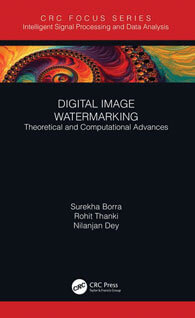Book Review: Digital Image Watermarking
Digital Image Watermarking: Theoretical and Computational Advances. By Surekha Bora, Rohit Thanki, and Nilanjan Dey. CRC Press; crcpress.com; 160 pages; $70.
 Digital imagery is present in all aspects of everyday life, from e-commerce, education, and voting to satellite imagery in military and nonmilitary applications. Security practitioners will be familiar with longstanding concepts of confidentiality, integrity, and authenticity relating to information and intellectual property of all kinds.
Digital imagery is present in all aspects of everyday life, from e-commerce, education, and voting to satellite imagery in military and nonmilitary applications. Security practitioners will be familiar with longstanding concepts of confidentiality, integrity, and authenticity relating to information and intellectual property of all kinds.
Digital Image Watermarking: Theoretical and Computational Advances is part of a series on Intelligent Signal Processing and Data Analysis. That’s the first clue to the scientific, calculation, and experiential emphasis in this technical work. The authors occupy leading roles in engineering and research, and the work abounds with references to earlier scientific findings, comprehensively attributed.
The book’s helpful introduction discusses the expanding role of digital image watermarking, its progression from basic digital rights management—used in, for example, copyright protection—to its application in multimedia, biometric, and digital medical enterprises. A useful summary of digital image watermarking performance criteria, for example the challenge of maintaining imperceptibility while achieving robustness to attacks, sets out the specific research areas necessary to advance understanding and competence in this area, and provides the framework for the book’s highly mathematical focus.
Much of the book is rooted in the calculations that seek to address these digital image watermarking challenges. While these technical calculations are essential to a scientific and academic readership, they will be largely incomprehensible to most commercial security practitioners.
The diligent reader, however, will find many useful insights into the future of this important topic: A fascinating chapter on artificial intelligence or machine learning draws from swarm analysis patterns of behavior in nature to examine how heuristic algorithms might dynamically protect digital imagery. An analysis on hardware-based solutions, while highly scientific, does provide the practitioner with the specifics for meaningful evaluation of some commercial solutions and their applicability to different types and qualities of digital imagery. Security practitioners seeking a fundamental overview will find a useful summary of applications of watermarking, respective benefits, and drawbacks.
Reviewer: Sarah Bynum, CPP, CISSP, is director of security at Siemens A.G. and a member of the ASIS Utilities Security Council. She is particularly interested in the convergence of physical and information security and the use of artificial intelligence to enhance physical security measures and human performance.